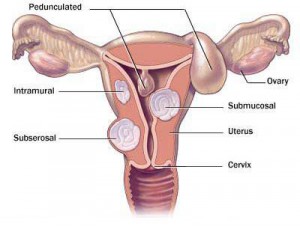
Surgery for uterine tumors can involve removing the entire uterus – known as a hysterectomy. While hysterectomy is a proven way to get rid of fibroids, it may not be the best treatment for every woman.If you want to keep your uterus but not necessarily get pregnant in the future, there are a number of prescription drug treatments that may help to stop fibroid growth or even shrink them. If you hope to later become pregnant, you may want to consider alternatives to hysterectomy like myomectomy. During myomectomy, surgeons remove the fibroids but not your uterus.
Treatment :
Treatment depends on several things, including:
- Your age
- General health
- Severity of symptoms
- Type of fibroids
- Whether you are pregnant
- If you want children in the future
Some women may just need pelvic exams or ultrasounds every once in a while to monitor the fibroid’s growth.
Treatment for the symptoms of fibroids may include:
- Birth control pills (oral contraceptives) to help control heavy periods
- Intrauterine devices (IUDs) that release the hormone progestin to help reduce heavy bleeding and pain
- Iron supplements to prevent or treat anemia due to heavy periods
- Nonsteroidal anti-inflammatory drugs (NSAIDs) such as ibuprofen or naprosyn for cramps or pain
- Short-term hormonal therapy injections to help shrink the fibroids
Surgery and procedures used to treat fibroids include:
- Hysteroscopic r
esection of fibroids: Women who have fibroids growing inside the uterine cavity may need this outpatient procedure to remove the fibroid tumors.
- Uterine artery embolization: This procedure stops the blood supply to the fibroid, causing it to die and shrink. Women who may want to become pregnant in the future should discuss this procedure with their health care provider.
- Myomectomy: This surgery removes the fibroids. It is often the chosen treatment for women who want to have children, because it usually can preserve fertility. More fibroids can develop after a myomectomy.
- Hysterectomy: This invasive surgery may be an option if medicines do not work and other surgeries and procedures are not an option.
To know more Fibroids Treatment- No Surgery in India please visit this link :
https://safemedtrip.com/medical-services/laparoscopic-minimally-invasive-surgery-in-india/fibroids-treatment-in-india.html

 Click to WhatsApp
Click to WhatsApp +91-9899993637
+91-9899993637
 esection of fibroids: Women who have fibroids growing inside the uterine cavity may need this outpatient procedure to remove the fibroid tumors.
esection of fibroids: Women who have fibroids growing inside the uterine cavity may need this outpatient procedure to remove the fibroid tumors.


